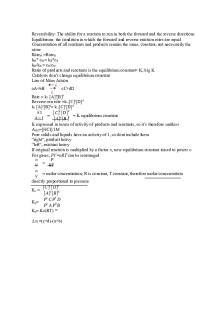Equilibrium notes PDF

| Title | Equilibrium notes |
|---|---|
| Author | Teresa McDaniels |
| Course | Principles Of Chemistry I |
| Institution | Case Western Reserve University |
| Pages | 6 |
| File Size | 246.8 KB |
| File Type | |
| Total Downloads | 70 |
| Total Views | 144 |
Summary
Short list of things we learn about chemical equilibrium...
Description
Chapter 14. CHEMICAL EQUILIBRIUM 14.1 THE CONCEPT OF EQUILIBRIUM AND THE EQUILIBRIUM CONSTANT Many chemical reactions do not go to completion but instead attain a state of chemical equilibrium. Chemical equilibrium: A state in which the rates of the forward and reverse reactions are equal and the concentrations of the reactants and products remain constant. ⇒ Equilibrium is a dynamic process – the conversions of reactants to products and products to reactants are still going on, although there is no net change in the number of reactant and product molecules. For the reaction: N2O4(g)
2NO2(g)
N2O4
Forward rate
concentration
Rate
NO2
Reverse rate
time
time
The Equilibrium Constant For a reaction:
aA + bB
equilibrium constant:
cC + dD Kc =
[C ]c [ D]d [ A]a [B ]b
The equilibrium constant, Kc, is the ratio of the equilibrium concentrations of products over the equilibrium concentrations of reactants each raised to the power of their stoichiometric coefficients. Example. Write the equilibrium constant, Kc, for N2O4(g)
2NO2(g)
Law of mass action - The value of the equilibrium constant expression, Kc, is constant for a given reaction at equilibrium and at a constant temperature. ⇒ The equilibrium concentrations of reactants and products may vary, but the value for Kc remains the same.
Other Characteristics of Kc 1) Equilibrium can be approached from either direction. 2) Kc does not depend on the initial concentrations of reactants and products. 3) Kc does depend on temperature.
Magnitude of Kc ⇒ If the Kc value is large (Kc >> 1), the equilibrium lies to the right and the reaction mixture contains mostly products. ⇒ If the Kc value is small (Kc...
Similar Free PDFs

Equilibrium notes
- 6 Pages

Chapter 18 Equilibrium Notes
- 3 Pages

Solubility Equilibrium
- 8 Pages

Equilibrium Lab
- 6 Pages

Equilibrium - Lab Report
- 9 Pages

Asset-Market Equilibrium
- 29 Pages

DIAGRAM FASA EQUILIBRIUM Fe3C
- 13 Pages

Equilibrium of Force System
- 89 Pages

Puncutated Equilibrium Theorie
- 2 Pages

31 Equilibrium-S Answers
- 10 Pages

Equilibrium Application Project
- 2 Pages
Popular Institutions
- Tinajero National High School - Annex
- Politeknik Caltex Riau
- Yokohama City University
- SGT University
- University of Al-Qadisiyah
- Divine Word College of Vigan
- Techniek College Rotterdam
- Universidade de Santiago
- Universiti Teknologi MARA Cawangan Johor Kampus Pasir Gudang
- Poltekkes Kemenkes Yogyakarta
- Baguio City National High School
- Colegio san marcos
- preparatoria uno
- Centro de Bachillerato Tecnológico Industrial y de Servicios No. 107
- Dalian Maritime University
- Quang Trung Secondary School
- Colegio Tecnológico en Informática
- Corporación Regional de Educación Superior
- Grupo CEDVA
- Dar Al Uloom University
- Centro de Estudios Preuniversitarios de la Universidad Nacional de Ingeniería
- 上智大学
- Aakash International School, Nuna Majara
- San Felipe Neri Catholic School
- Kang Chiao International School - New Taipei City
- Misamis Occidental National High School
- Institución Educativa Escuela Normal Juan Ladrilleros
- Kolehiyo ng Pantukan
- Batanes State College
- Instituto Continental
- Sekolah Menengah Kejuruan Kesehatan Kaltara (Tarakan)
- Colegio de La Inmaculada Concepcion - Cebu




